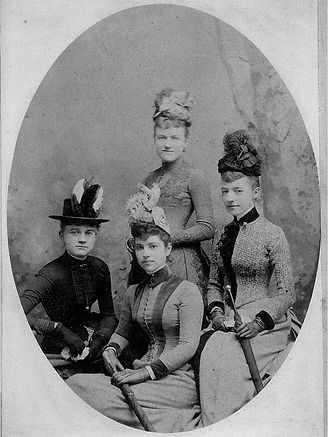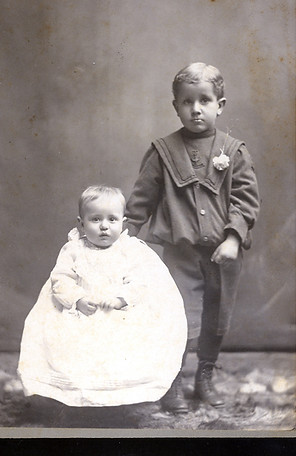
1870s Fashion
1870s Fashion
The Trends
The Trends
The Trends
1880s Fashion
Attempting to differentiate the fashion of the 1880s from those of the 1870s can often be confusing, especially when considering the use of the bustle which had popularity in both decades. The "second bustle era" began halfway through the 1880s and continued through the decade. It is easiest to consider the fashion in the 1870s as a soft style with excessive decoration in the form of texture from added fabric while the desired effect of 1880s fashion was a more angular, tailored look.
Some of the most apparent changes are to bodices worn during the day, which had collars that rose several inches above the shoulders, shorter sleeves ending above the wrist, and the simplification of cut and decoration which gives a “plain above, fancy below” appearance. Women also chose thicker fabrics like wool, brocades, and velvet which were consistent with a more structured look. The trained hem was no longer the preferred style and most dresses did not extend all the way to the floor, showing off the shoes of the wearer, typically side-buttoning boots of leather or woven fabric.

Photographed by C. S. German , c. 1881
Image courtesy of Richard E. Hart

Photographed by Gustave W. Jorns, c. 1874-82
Image courtesy of Richard E. Hart

Hattie Lobbins, photographer unknown, c. 1880-85
Image courtesy of the UIS Archives
With the resurgence of the bustle, skirts were still “fancy” by utilizing texture, bows, and layers in the form of apron fronts and overskirts, but the overall look was very angular, both in decoration and in the structure of the bustle itself. Although the bustle was worn once again, the hard lines dictated by fashion brought its shape closer to a shelf rather than a gathering of excess fabric. Despite the technological advances that produced the accordion, or collapsible bustle enabling women to sit comfortably, the extreme version would only be utilized by those whose lifestyles allowed for encumbered movement. Satirical cartoons of the time portrayed the underlying structure as a birdcage, rigged to stay under the women’s skirts, or more enjoyable, to hide a second pair of legs, suggesting their true form as that of a horse.

Photographed by Charles W. Gardnier, c. 1887 Image courtesy of Richard E. Hart

Photographed by William F. Truesdell, c. 1884-88 Image courtesy of Richard E. Hart

Photographed by L. Sperry Anderson, c. 1884-90
Image courtesy of Richard E. Hart

Photographed by Finley McNulty, c. 1880-90
Image courtesy of the Sangamon Valley Collection
As if the “hard” bustle was not enough in the lady’s arsenal of clothing, the popularity of the curaisse bodice would dominate the decade. This “corset-like bodice…encasing the whole torso, like an armoured sheathe, [gave] the body a smooth and elegant shape, with a well-defined waist and pronounced curves.” To achieve this look, the cut was much closer to the body, including the sleeves which ended above the wrist and began higher on the shoulder, making shoulders appear shorter. To emphasize the triangular shape of the bodice and fully adopt men’s styling, accent fabric was placed at the center of the bodice, creating the illusion of a vest which was then closed with buttons light in color. This would eventually include military styles which were decorated with velvet and wool, metal buttons, and corded appliques. The overall look was completed with tight up-dos and bangs topped with traditional brimmed hats, small bonnets, and toques. These sat high on the head and were adorned with feathers and bows, giving the appearance of a plumed helmet.

Photographed by Daniel J. Ryan, c. 1887-89
Image courtesy of Richard E. Hart

Photographed by L. S. Anderson, 1884-90
Image courtesy of Richard E. Hart

Photographed by Halliday & Kessberger, c. 1886-90
Image courtesy of the Sangamon Valley Collection

Photographed by Hurt & Sidwell, c. 1890-91
Image courtesy of Richard E. Hart

By 1888 the bustle was on its way out and the tightness of dress began to lessen, skirts were a traditional A-line shape without overskirts and apron fronts. The early style of the mutton sleeve can be detected as the tight seam of the shoulder was not only relieved but included extra fabric giving it a small “puffed” effect. The high collar was still fashionable and was decorated with lace and bows in order to make the triangular look of the 1880s even more extreme. The 1890s, true to fashion theory, would be one of softer lines and additional fabric, becoming “fancy above, plain below,” in a flip of previous fashions.
Photographed by C. S. German , c. 1885-91
Image courtesy of Richard E. Hart
As will be a recurring theme throughout this project, men’s fashion changed little from the previous decade but there were some noticeable differences. The three-piece suit continued to be the preferred choice for day wear, but not unlike women’s fashion, the cut was closer to the body, including the lapel which became smaller. A variety of jacket styles remained popular; the tail for formal occasions, the longer frock coat typically worn in colder months, and the sack being the least formal and traditional choice of the working class. The most popular during this period, was the cutaway jacket. This garment had a rounded center front which was left open while the top buttons remained closed to show the vest of the wearer and became the preferred way to display wealth and conspicuous consumption by displaying fancy vests and watch chains.

Photographed by Charles W. Gardnier, c. 1888-91
Image courtesy of Richard E. Hart

Group of men before a ball at the Leland Hotel, 1889
Image courtesy of the Sangamon Valley Collection
Though the suits of the day were three pieces, this did not mean all three matched, as patterns were welcome if not encouraged. Both the string and boxy bowties of the 1870s had been replaced by bowties and neckties not unlike modern variations. Ensembles were completed by the boot, still dark in color but now with a slightly narrow and rounded toe. The final touch for most men of this era was their facial hair. Older gentlemen still sported a full beard, but most men chose to wear a styled mustache, with shorter hair that was styled into a side-part.
Children continued to wear miniature versions of adult fashion once they had graduated from the light sack style garments of infancy and the toddler years. It was not uncommon for young girls to also wear small, malleable bustle pads which their fashions. Additionally, girls wore shorter dresses, often pared with dark stocking and boots, and as they aged the skirts would get longer until they reached maturity and were required to dress as women did, with full length skirts and styled up-dos.
A fad in children’s wear during the 1880s, typically with boys, was the sailor suit, which consisting of nautical themed jackets and shorts, often pared with a tied collar, stockings and boots. With the publication of the children’s book Little Lord Fauntleroy in 1886, middle class boys were also dressed in ensembles called the Fauntleroy suit. Structurally it was not unlike the sailor suit, comprising of a jacket and short set, usually of velvet, decorated with lace collar and oversized bowtie.

Eugene Ensell, Hal Patton, and Roy Idle, 1881
Image courtesy of the Sangamon Valley Collection

Photographed by Halliday & Kessberger, c. 1888-92
Image courtesy of Richard E. Hart

Photographed by Henry Pietz, 1887
Image courtesy of Richard E. Hart

Photographed by Springer, c. 1885-90
Image courtesy of Richard E. Hart

Photographed by Henry Halliday, c. 1886-1900
Image courtesy of Richard E. Hart
[1] Charles H. Gibbs-Smith, The Fashionable Lady in the 19th Century. (London: Her Majesty’s Stationery Office, 1960), 68.
[2] Ibid., 7.
[3] Judith Flanders, Inside the Victorian Home: A Portrait of Domestic Life in Victorian England (W. W. Norton, 2005), 304.